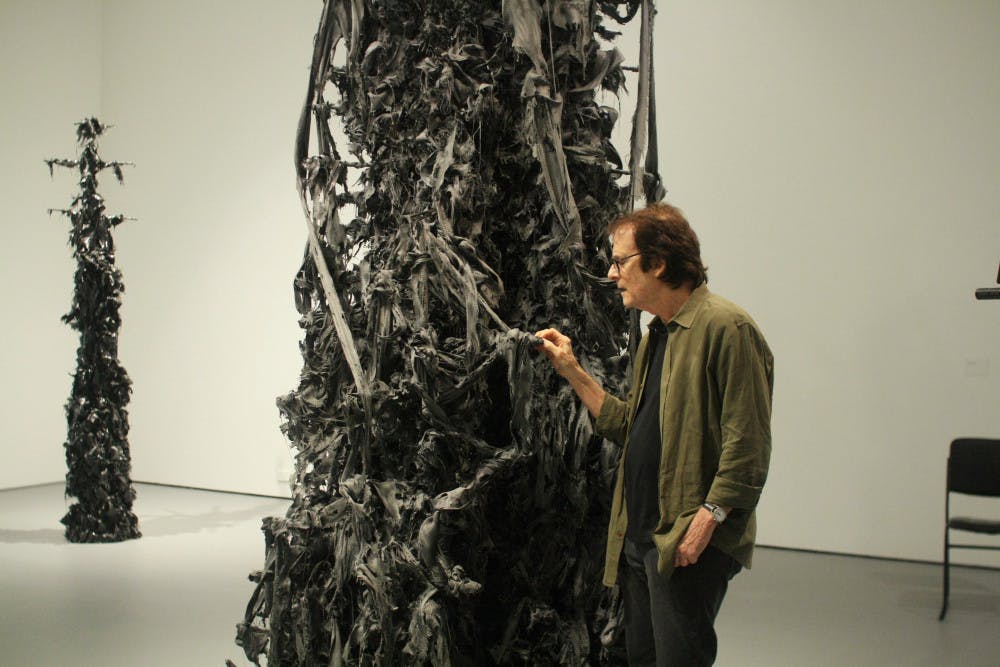From September through October, a large elm log, stripped of its bark and sliced into 56 pieces, rested in the middle of the lobby of the List Art Center as a part of Richard Fishman’s exhibition “What Remains.” The David Winton Bell Gallery itself contained the rest of Fishman’s pieces — gray and black protrusions that began as deconstructions of the elm tree fused with carbon composite and progressed toward pure carbon structures, devoid of any wood element.
An artist talk and vocal performance on “What Remains” occurred Thursday, though the exhibition itself closed Sunday.
The elm tree, from which earlier pieces in the collection were derived, was originally a giant tree on Thayer street in front of the Watson Institute of International and Public Affairs. It was cut down in 2003 because it was sick, and Fishman, a professor of visual art at the University, repurposed the tree for his Elm Tree Project that used carbon fibers in combination with elm tree slabs, creating a link between the inorganic and the organic. He used carbon fibers to strengthen the slabs of elm as they were cut, so that there would be no breakage.
“I used carbon fiber because I’d never used it before, … and it was super light and super strong. But then I liked its blackness. And I liked the process,” Fishman said.
“No Apparent Source of Light,” the sculpture part of the collection, appeared unimposing, resting on the furthest wall of the exhibition room. A dark, smooth piece, it evoked a soft luminosity that made the audience think of moonlight.
“My pieces — I make them to touch. And to get to the point that it is so sensuous that it would drive you crazy,” Fishman said. “In the making of things, … there’s a great satisfaction I find. And using my hands … to translate all of the various emotions that come from touch,” Fishman said.
“This is … a ton of time with really slow work. … It’s just a piece of wood that’s sanded. Like the process is totally hidden, we have no idea how he made this,” said Frans van Hoek ’18, who attended the event and said he found “No Apparent Source of Light” to be the piece that he had the most visceral reaction to. “You can remove all traces of yourself but still communicate all of yourself,” he added.
The works in the lobby “are the introduction to the show, the works created towards the end of when he was working with the elm,” said Jo-Ann Conklin, the director of the David Winton Bell Gallery. “The later ones are totally carbon fiber. … None of the elm tree exists under these new pieces. He’s moved on beyond the elm tree.”
“I was interested in the transition away from working with the wood and what happened when the wood disappeared. And so ‘What Remains’ is sort of a multifaceted title. Part of it is what remains when the wood is not present anymore,” Conklin added.
Fishman’s talk was preceded by an improvised vocal performance by Laurie Amat, a local vocalist. The performance occurred in the space that held Fishman’s most recent, pure carbon fiber sculptures — four slabs of sleek and shiny carbon pieces that gleamed back the audience’s reflection.
“If you look, you can see the whole world in there … The finish is beautiful,” Amat said, adding that she offered to do a performance after having an extremely visceral response when she saw the exhibition for the first time. “What I do is pretty visceral, so I kind of had a plan, but when I came in today … it got deep, really fast. … it’s hard for me to describe (the performance), but it happened. I mean, this is amazing, this work. It makes me want to play with carbon fiber.”
“You think it’s just black, but it’s so alive,” she said.





